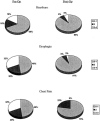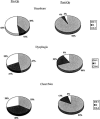Laparoscopic fundoplication failures: patterns of failure and response to fundoplication revision
- PMID: 10522729
- PMCID: PMC1420908
- DOI: 10.1097/00000658-199910000-00015
Laparoscopic fundoplication failures: patterns of failure and response to fundoplication revision
Abstract
Objective: To determine rates and mechanisms of failure in 857 consecutive patients undergoing laparoscopic fundoplication for gastroesophageal reflux disease or paraesophageal hernia (1991-1998), and compare this population with 100 consecutive patients undergoing fundoplication revision (laparoscopic and open) at the authors' institution during the same period.
Summary background data: Gastroesophageal fundoplication performed through a laparotomy or thoracotomy has a failure rate of 9% to 30% and requires revision in most of the patients who have recurrent or new foregut symptoms. The frequency and patterns of failure of laparoscopic fundoplication have not been well studied.
Methods: All patients undergoing fundoplication revision were included in this study. Symptom severity was scored before and after surgery by patients on a 4-point scale. Evaluation of patients included esophagogastroscopy, barium swallow, esophageal motility, 24-hour ambulatory pH, and gastric emptying studies. Statistical analysis was performed with multiple chi-square analyses, Fisher exact test, and analysis of variance.
Results: Laparoscopic fundoplication was performed in 758 patients for gastroesophageal reflux disease and in 99 for paraesophageal hernia. Median follow-up was 2.5 years. Thirty-one patients (3.5%) have undergone revision for fundoplication failure. The mechanism of failure was transdiaphragmatic herniation of the fundoplication in 26 patients (84%). In 40 patients referred from other institutions, after laparoscopic fundoplication, only 10 (25%) had transdiaphragmatic migration (p < 0.01); a slipped or misplaced fundoplication occurred in 13 patients (32%), and a twisted fundoplication in 12 patients (30%). The failure mechanisms of open fundoplication (29 patients) followed patterns previously described. Fundoplication revision procedures were initiated laparoscopically in 65 patients, with six conversions (8%). The morbidity rate was 4% in laparoscopic procedures and 9% in open ones. There was one death, from aspiration and adult respiratory distress syndrome after open fundoplication. A year or more after revision operation, heartburn, chest pain, and dysphagia were rare or absent in 88%, 78%, and 91%, respectively, after laparoscopic revision, and were rare or absent in 91%, 83%, and 70%, respectively, after open revision, but 11 patients ultimately required additional operations for continued or recurrent symptoms, 3 after open revision (17%), and 8 after laparoscopic fundoplication (11%).
Conclusions: Laparoscopic fundoplication failure is infrequent in experienced hands; the rate may be further reduced by extensive esophageal mobilization, secure diaphragmatic closure, esophageal lengthening (applied selectively), and avoidance of events leading to increased intraabdominal pressure. When revision is required, laparoscopic access may be used successfully by the laparoscopically experienced esophageal surgeon.
Figures








References
-
- Sparcs Discharge Database, New York State Bureau of Health Statistics, 1999.
-
- Centers for Disease Control Bureau of Health Statistics, Rockville, MD, 1987.
-
- Synergy Healthcare, Inc., Waltham, MA, 1999.
-
- Hiebert CA, O’Mara CS. The Belsey operation for hiatal hernia: : a twenty-year experience. Am J Surg 1979; 137: 532. - PubMed
Publication types
MeSH terms
LinkOut - more resources
Full Text Sources
Medical

